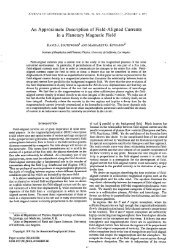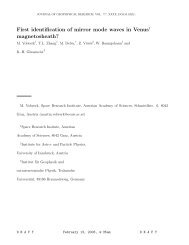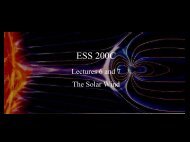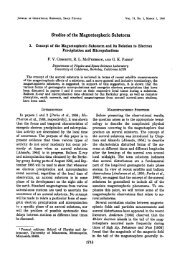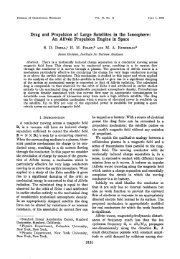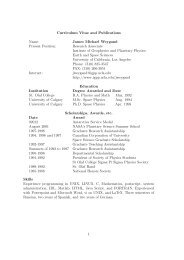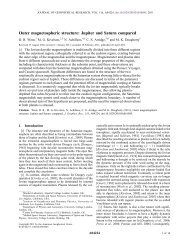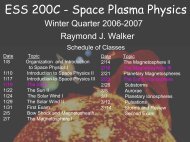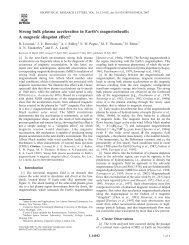Modeling 3-D Solar Wind Structure.pdf
Modeling 3-D Solar Wind Structure.pdf
Modeling 3-D Solar Wind Structure.pdf
Create successful ePaper yourself
Turn your PDF publications into a flip-book with our unique Google optimized e-Paper software.
Lecture 13<br />
<strong>Modeling</strong> 3-D 3 D <strong>Solar</strong> <strong>Wind</strong><br />
<strong>Structure</strong>
Why is a Heliospheric Model Needed?<br />
• Space weather forecasts require us to know the solar<br />
wind that is interacting with the magnetosphere.<br />
• <strong>Solar</strong> events like CMEs can cause magnetic storms and<br />
our maximum warning comes if we can predict their<br />
paths from the Sun.<br />
• On the way to the Earth they encounter structures in the<br />
solar wind and these interactions can modify their ability<br />
to cause geo-effective disturbances at Earth.<br />
• Need computational models that include the propagation<br />
and evolution of the solar wind on the way to Earth.
Enlil was the Sumarian Lord of the<br />
<strong>Wind</strong>
Formulation of ENLIL: MHD Equations<br />
∂<br />
∂t<br />
∂<br />
∂t<br />
+ ∇ ⋅<br />
( ρV) = 0<br />
⎛ BB ⎞<br />
⎜ μ ⎟<br />
⎝ o ⎠<br />
GM<br />
r<br />
( ρ V) + ∇ ⋅ ( ρVV<br />
) = −∇ ⋅⎜<br />
⎟ + ρ<br />
2<br />
∂<br />
∂t<br />
( E ) + ∇ ⋅ ( EV<br />
) = − p∇<br />
⋅ ( V )<br />
∂<br />
( B ) = ∇ × ( V × B)<br />
∂t<br />
• Ρ is the mass density, V is the mean flow velocity, B is<br />
the magnetic field, P is the pressure (thermal, p, and<br />
magnetic B 2 / 2μ o ), μ o is the permeability, G is gravity, M S<br />
is the solar mass, and E is the thermal energy density<br />
(p/(γ-1) with γ the ratio of specific heats.<br />
• A thermal energy equation is used because it gives<br />
smooth profiles of thermal pressure and temperature but<br />
may interfere with shock capture.<br />
s
Formulation of ENLIL: Additional Continuity<br />
Equations<br />
• In some applications two additional contributions are<br />
included in the continuity equations<br />
∂<br />
∂t<br />
∂<br />
∂t<br />
( ρ ) + ∇ ⋅( ρ ) = 0<br />
c<br />
c V<br />
( ρ ) + ∇ ⋅( ρ ) = 0<br />
p<br />
p V<br />
these allow us to trace injected CME material (ρ c ) and<br />
magnetic field polarity (ρ p ).
Formulation of ENLIL: Solving the Equations<br />
• The temperature is calculated from an equation of state<br />
p = 2nkT<br />
where n is the number density.<br />
• Available in Cartesian or spherical coordinates.<br />
• Uses the Total-Variation-Diminishing Lax-Fredrich<br />
scheme.<br />
• No artificial diffusion.<br />
• Second order accurate.<br />
• Field-interpreted central-difference approach is used to<br />
solve for B so that ∇ ⋅B<br />
= 0<br />
• Uses adaptive mesh.
Launch a CME into the Streamer Belt<br />
• Most CMEs are launched into the coronal streamer<br />
belt.<br />
•Launch an over-pressured spherical plasmoid into<br />
tilted, slow and dense streamer belt.<br />
• Launch CME at fast SW speed which is twice slow<br />
SW speed.
The CME will Interact with both the Slow<br />
Flow and the Fast Flow<br />
• Cuts at two latitudes – green lines.
The Interaction<br />
• As the CME passes through the streamer belt it<br />
decelerates.<br />
• Leading edge of the fast stream interacts with the slow<br />
streamer belt flow and forms a pair (forward and reverse)<br />
of shocks.<br />
• The CME is trapped between the fast coronal hole flow<br />
and the slow streamer belt – it is sandwiched with the<br />
CIR structure.<br />
• The CME effects the CIR evolution as well – the trailing<br />
CIR is eroded.
Interaction between a CME and CIR<br />
Forward Shock<br />
Reverse Shock
A Slice Below the Equatorial Plane<br />
• The bottom panel show a<br />
time series at same<br />
colatitude at 3AU and<br />
fixed azimuth.<br />
• The shaded area<br />
indicates the CME<br />
material and the dotted<br />
line shows the injected<br />
number density profile.<br />
• The CME penetrates into<br />
the trailing region of the<br />
preceding fast stream.<br />
• The forward shock<br />
weakens and becomes a<br />
pressure wave.<br />
Forward Shock<br />
• The reverse shock forms at leading edge of CME and<br />
propagates backward through the CME material<br />
Reverse Shock
Ambient <strong>Solar</strong> <strong>Wind</strong><br />
• Need to have a model of the ambient solar wind for the<br />
CME to propagate into.<br />
• Radial magnetic field uses a potential source-surface<br />
model and observations from a solar observatory (Wilcox<br />
<strong>Solar</strong> Observatory in the example).<br />
• The azimuthal magnetic field uses B<br />
ϕ<br />
= −Br sin(θ ) Vrot V r<br />
• The radial velocity at the Sun uses the Wang-Sheeley-<br />
Arge model.<br />
• The meridional magnetic field (B θ ) and the meridional<br />
and azimuthal flow velocities (V θ and V φ ) are zero.
Source Surface Model and Velocity at 1AU<br />
• Results are near solar minimum.<br />
• Model has be altered slightly give velocities between 275<br />
and 625 km/s.
CME on May 12, 1997<br />
• Cone model used to characterize halo CME.<br />
– Angular width of 50 0 and central axis of the cone pointing to 3 0<br />
north and 1 0 west.<br />
– Velocity of 650 km/s at 24R S<br />
– Accelerating at 18.5 m s -2<br />
• Input pulse was a spherical plasma cloud at the location,<br />
diameter and velocity given by the cone model<br />
parameters.<br />
• Density set to be 4 times the mean value in fast stream.<br />
• Temperature equal to value in fast stream.
Distribution of <strong>Solar</strong> <strong>Wind</strong> Parameters<br />
• Background contains solar maps used- distribution is at<br />
21.5R S<br />
• Circles show the spherical injection and values used.
Evolution of the <strong>Solar</strong> <strong>Wind</strong> Parameters at Earth<br />
• Simulation black lines with shading.<br />
• <strong>Wind</strong> observations are in red diamonds.<br />
• Orange gives the injected density.<br />
• Dashed line is the forward shock or compression.<br />
• Solid vertical lines extent of CME material<br />
• Ambient solar wind ahead of CME in good agreement<br />
• Shock compression good agreement but smoothed.
Visualization of Propagating CME<br />
• Background solar wind<br />
velocity on inner<br />
boundary and equator<br />
(0.1AU).<br />
• Isosurface at 6 cm -3<br />
color coded with<br />
velocity.<br />
• Contours ahead of<br />
CME are on isosurface<br />
at 20 cm -3.<br />
• Injected material<br />
covers large region but<br />
interaction with solar<br />
wind is greatest near<br />
equator.<br />
Earth
Evolution of CME as<br />
Function of Radial<br />
Distance<br />
• Time series of velocity at<br />
selected radial distances<br />
along Sun-Earth line.<br />
• Dotted line is background<br />
solar wind- note high<br />
speed stream.<br />
• With distance<br />
compressive pressure<br />
wave of CME merges with<br />
the CIR.<br />
• Forward and reverse<br />
shock pair form about<br />
0.4AU and separate.
Effect of Time Dependent <strong>Solar</strong> Models<br />
• Previous calculation used one set of solar maps for the<br />
entire solar rotation- tried variable solar wind maps.<br />
– Odstrcil used a variable set of maps giving a “pseudo” time<br />
dependence to the solar input.<br />
– A potential field is assumed ( B = −∇ϕ)<br />
and observations are fit<br />
with spherical harmonics.<br />
– Pasted together pieces from CRs 1921, 1922, 1923 and then<br />
created 90 daily maps.<br />
– First map went from 180 0 at CR 1922 (CR1922.180) and ended<br />
at CR1921:180, next CR1922:176 to CR1921:176<br />
– The first daily updated map was assigned central median<br />
passing time of CR 1922:000.<br />
– The results were similar fixed map at the Earth.<br />
• Explosion of CME is more than just a centered spherical<br />
injection – sudden displacement model,<br />
– Sudden northward displacement of the southern fast stream<br />
boundary.
Comparison of Time<br />
Dependent Models and<br />
Sudden Displacement<br />
Models<br />
• Top contains results<br />
from “pseudo” time<br />
dependent maps.<br />
• Bottom contains results<br />
from sudden<br />
displacement model<br />
• Neither seems to be a<br />
great improvement.<br />
• Model is sensitive to<br />
parameters at the Sun.
Results at Other Locations at 1AU – Fixed<br />
Rotation Model<br />
• Time series at 1 AU at various.<br />
• Circle shows the velocity.<br />
• Vertical black lines give spread in injected material.
Results at Other Locations at 1AU –Sudden<br />
Displacement Model<br />
• Models give different CME configurations.



